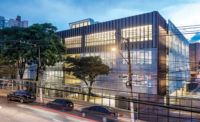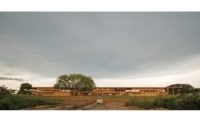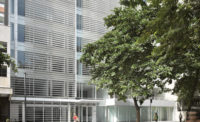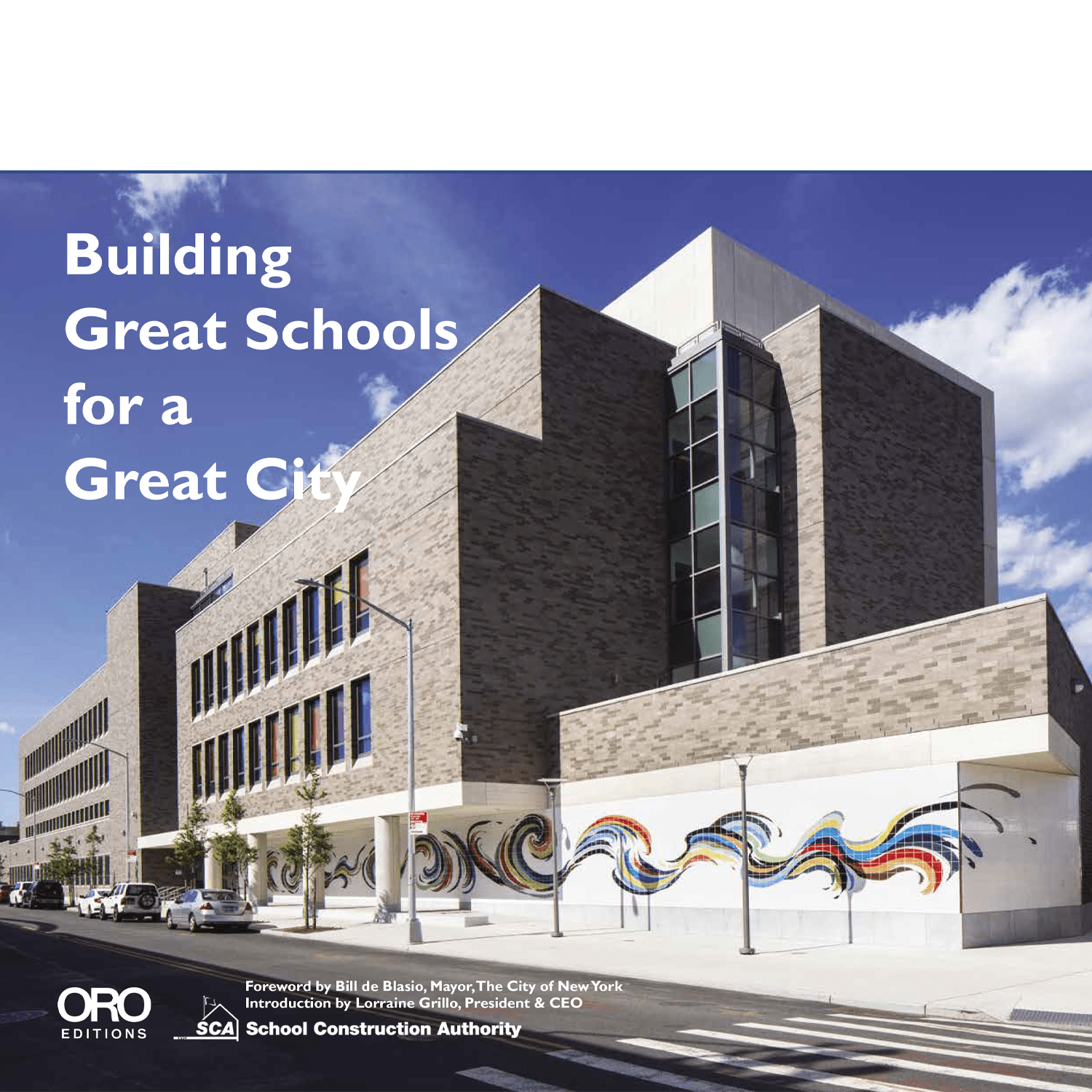The MOPI School
An innovative school reflects its lush rain forest surroundings and creative pedagogy through its form and materials.

Sitting on top of reused wood from electricity poles, the building’s oxidized copper facade is supported by beams of laminated eucalyptus and evokes the nearby rain forest. The use of copper panels with small perforations allows for airflow yet still provides shelter from sun and rain.
Photo © Leonardo Finotti

The building comprises four elliptical volumes built in three phases, with an emphasis on maintaining its architectural coherence. Curving external ramps and balconies reveal stunning mountain views at the back of the building.
Photo © Leonardo Finotti

The building comprises four elliptical volumes built in three phases, with an emphasis on maintaining its architectural coherence. The gym clad with a perforated aluminum composite that blends with the copper, was part of the third phase.
Photo © Leonardo Finotti

The building comprises four elliptical volumes built in three phases, with an emphasis on maintaining its architectural coherence. The gym clad with a perforated aluminum composite that blends with the copper, was part of the third phase.
Photo © Leonardo Finotti

Playful colors serve as a location device throughout the building.
Photo © Leonardo Finotti

Playful colors serve as a location device throughout the building, while channel glass is used in most classrooms to maximize daylight inside the building.
Photo © Leonardo Finotti

To ensure accessibility for physically disabled students, the architects employed a series of color- coded ramps. The building’s one staircase was mandated by the city fire codes.
Photo © Leonardo Finotti

Façade detail
Photo © Leonardo Finotti

Longitudinal Sections A-A and B-B
Image courtesy Mareines+Patalano

Ground-Level Plan
Image courtesy Mareines+Patalano

Second-Level Plan
Image courtesy Mareines+Patalano

Third-Level Plan
Image courtesy Mareines+Patalano

Street Elevation
Image courtesy Mareines+Patalano













Architects & Firms
Mazar-i-Sharif, Afghanistan
Established in Rio de Janeiro’s northern neighborhood of Tijuca in 1973, the MOPI school was planning to open a facility in the rapidly growing Barra region to the west. Its founders wanted a building that would introduce the private school’s innovative teaching approach to the area’s upwardly mobile population. “So it was fundamental that the building use the same architectural language as our pedagogical philosophy,” says Vinicius Canedo, MOPI administrator and son of school founder Regina Canedo. Canedo sought to break with Brazil’s traditional teaching by promoting creativity and stimulating social and environmental responsibility. MOPI stands for Moderna Organização Pedagógica Infantil, or Modern Organization of Juvenile Pedagogy.
The Canedos turned to the local practice Mareines+Patalano to design the new school for nursery through high school–age children, finding like minds in architects Ivo Mareines and Rafael Patalano. The partners describe themselves as fans but not followers of the neomodernist trend that currently dominates Brazilian architecture, as exemplified by the work of Marcio Kogan. Instead, they draw their inspiration from Brazil’s architectural traditions before European colonization. “Brazil is a country of excess, and we are interested in how our indigenous peoples responded to their environment, with its excess of sun, humidity, and rain,” says Mareines.
This concern with place is immediately apparent in MOPI’s striking street facade. Composed of green pre-oxidized perforated copper panels attached to laminated wood beams, it evokes the rain forest, which rears up behind the school along the slopes of Rio’s iconic Gávea mountain. During the day, the panels appear opaque from the outside, while semitransparent from inside. At night, the effect is reversed, and the facade lets the light and movement within the school become visible from the street. The perforated panels allow for the circulation of fresh air throughout the interior, yet also provide shelter from Rio’s tropical downpours and shade from its often intense sun. This natural ventilation all through the structure results in an air-conditioning bill far lower than Rio’s humid climate would seem to dictate.
A fluid interplay between interior and exterior permeates the rest of the poured-in-place concrete structure. The building comprises four separate volumes linked by a series of external color-coded balconies, with the building’s rear dramatically opening onto views of the rain forest. This emphasis on harmony with nature is reinforced by the architects’ use of materials. The facade sits on top of wood beams once used for electricity poles; sustainable eucalyptus covers the roof of the outdoor swimming pool; recycled rubber and plastics surface flooring in play areas; and much of the water is supplied by captured rain. There is even a vegetable garden and coops for chickens and tropical birds.
Fittingly for an institution that wants to teach children to think outside the box, they are not asked to learn while sitting inside one. “We live in boxes big and small. At MOPI, you are never sitting within four [orthogonal] walls. No two spaces are the same. There is no obvious logic. It is a less harsh, much richer learning experience,” says Mareines.
The school is endlessly playful and as sinuous as Rio itself, with classroom walls bending along the elliptical lines of the volumes that make up the structure. This use of curves solves MOPI’s requirement that the building be accessible to physically disabled students. The only staircase in the entire structure was mandated by the city’s fire codes. Otherwise, access to upper balconies is by a series of looping ramps that are a manifestation of the school’s dedication to inclusion.
Built over three phases as its student body grew and advanced through the upper grades, MOPI today has over 800 children aged 2 to 17. Planning for the project started in 2007, with the first phase delivered in 2009. Phase two was completed in 2010, and the third delivered in 2015. When the decision was first made to expand the school, both client and design team insisted on maintaining the coherence of the original project, seamlessly integrating the distinct phases to create a unified whole. When cost ruled out using the copper panels on the facade of the third phase, Mareines+Patalano turned to less expensive panels made of an aluminum composite, giving the building skin a variegated color scheme utterly in keeping with its rain forest motif.
The investment in such an innovative building has been more than worthwhile, say the school’s owners. “Parents want their children to study here, and the numbers back this up,” says Canedo. “We see fewer kids taken out before graduating than the average turnover rate in the sector.”
It is easy to imagine why parents might be reluctant to move their children elsewhere. MOPI is like the sort of attraction kids get to enjoy on a field trip rather than a regular place of learning. “Here it’s like coming to school in an amusement park,” says 9-year-old Maia. “It’s colorful, and we get to learn while playing. You feel happier here.”
People
Architect: Mareines + Patalano Arquitetura
Personnel in architect's firm who should receive special credit: Ivo Mareines, Rafael Patalano, project architects Flavia Lima, Project leader Design team: Bruno D’acri, Felipe Guimarães, Camille Reiss, Carmen Gottschall, Luciana Engel, Gabriel Vicente, Matthieu Van Beneden, Danilo Moreno
Interior designer: Mareines + Patalano arquitetura
Consultants: Landscape: Vistara Paisagismo Lighting: Ana Moraes & Atelier da luz M/P/E :Edson Cravo A/C: Nelson collares, José Irala Structural (steel and concrete): Marcus Casz & MPNAICE Structural (glulam): Carlos Alberto Szücs Façade: N2 projetos
General Contractor: Kreimer Engenharia Client: MOPI Size: 60,400 square feet Cost: $8.1 million Completion date: February 2015 |
ProductsStructural system Concrete, Steel, Glulam
Exterior cladding Metal Panels: Perforated Pre-Oxidized Copper – Ndidini, Pilkington Profilit – T2g Wood: Glulam - Esmara EIFS, ACM, or Other: Perforated ACM - Reynobond Other cladding unique to this project: Reclaimed wood electricity posts on the façade
Roofing Aluminum and polyurethane insulated roofing: Panisol Waterproofing: Alwitra
Glazing Glass: Cebrace
Doors Entrances: custom made
Interior finishes Acoustical ceilings: Knauf Suspension grid: Knauf Paints and stains: International-Akzo Nobel Solid surfacing: Granite- Natural Stone Special surfacing: Sports court rlooring – Lisonda Floor and wall tile: Gail Resilient flooring: Lisonda
Furnishings Office furniture: Voko Reception furniture: Fernando Jaeger Chairs: Metadil Tables: Metadil
Lighting Interior ambient lighting: Lumini Downlights: Lumini Task lighting: Lumini Exterior: Lumini
Conveyance Accessibility provision (lifts, ramping, etc.): The school is fully accessible via 8% ramps
Other unique products that contribute to sustainability: Water saving faucets: Fabrimar Water saving urinals and toilets (presence sensor): Deca Passive cooling device: Perforated Pre-Oxidized Copper – Ndidini Pilkington Profilit – T2G Passive cooling device: Perforated ACM facade- Reynobond Aluminum and polyurethane insulated roofing: Panisol
Building components or special equipment that made a significant contribution to this project: Presence sensors for lighting in wc’s and changing rooms Light sensors for external lighting Rainfall water reuse |

















